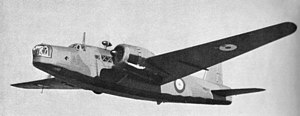
Back Vickers Wellington Afrikaans Vickers Wellington AN فيكرز ويلينغتون Arabic Vickers Wellington Azerbaijani Vickers Wellington Bulgarian Vickers Wellington Breton Vickers Wellington Catalan Vickers Wellington Czech Vickers Wellington Danish Vickers Wellington German
| Wellington | |
|---|---|

| |
| Wellington B Mark IA. The geodetic construction is evident through the Perspex windows along the aircraft's side. | |
| Role | Medium bomber anti-submarine aircraft |
| Manufacturer | Vickers-Armstrongs |
| First flight | 15 June 1936 |
| Introduction | October 1938 |
| Retired | March 1953 |
| Primary users | Royal Air Force Royal Australian Air Force Royal Canadian Air Force Fleet Air Arm |
| Produced | 1936–1945 |
| Number built | 11,461[1] or 11,462[2] |
| Developed into | Vickers Warwick Vickers VC.1 Viking |
The Vickers Wellington is a British twin-engined, long-range medium bomber. It was designed during the mid-1930s at Brooklands in Weybridge, Surrey. Led by Vickers-Armstrongs' chief designer Rex Pierson; a key feature of the aircraft is its geodetic airframe fuselage structure, which was principally designed by Barnes Wallis. Development had been started in response to Air Ministry Specification B.9/32, issued in the middle of 1932, for a bomber for the Royal Air Force.
This specification called for a twin-engined day bomber capable of delivering higher performance than any previous design. Other aircraft developed to the same specification include the Armstrong Whitworth Whitley and the Handley Page Hampden. During the development process, performance requirements such as for the tare weight changed substantially, and the engine used was not the one originally intended.
Despite the original specification, the Wellington was used as a night bomber in the early years of the Second World War, performing as one of the principal bombers used by Bomber Command. During 1943, it started to be superseded as a bomber by the larger four-engined "heavies" such as the Avro Lancaster. The Wellington continued to serve throughout the war in other duties, particularly as an anti-submarine aircraft with RAF Coastal Command.
The Wellington was the only British bomber that was produced for the duration of the war, and was produced in a greater quantity than any other British-built bomber. The Wellington remained as first-line equipment when the war ended, although it had been increasingly relegated to secondary roles. The Wellington was one of two bombers named after Arthur Wellesley, 1st Duke of Wellington, the other being the Vickers Wellesley.
A larger heavy bomber aircraft designed to Specification B.1/35, the Vickers Warwick, was developed in parallel with the Wellington; the two aircraft shared around 85% of their structural components. Many elements of the Wellington were also re-used in a civil derivative, the Vickers VC.1 Viking.
© MMXXIII Rich X Search. We shall prevail. All rights reserved. Rich X Search